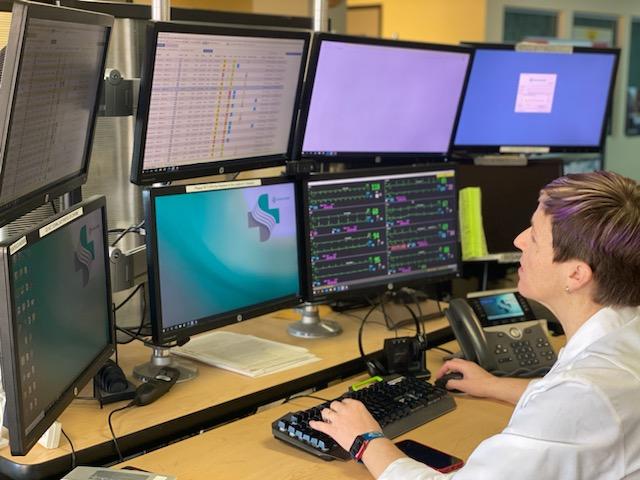By Karin Fleming, Gary Zavoral and Liz Madison, Vitals contributors
When Sutter Health in 2003 launched its groundbreaking electronic intensive care unit, or eICU, no one knew that 17 years later it would help save the lives of countless Northern Californians when a deadly pandemic raged around the world.
During the COVID-19 pandemic, critical-care doctors and nurses in two Sutter eICU hubs worked 24/7 to assist and coach on-the-ground staff in caring for upwards of 1,000 patients a day. It allowed many patients to stay in rural and community hospitals without the need for risky patient transfers to larger hospitals and helped preserve in-demand personal protective equipment for medical staff.
The path to recovery for these severely ill patients was made possible by Sutter’s eICU, which monitors and helps care for patients in 20 Sutter hospitals. The eICU is a sophisticated telemonitoring program that ensures critically ill patients in large and small communities have 24/7, remote access to an expert team of Sutter Health network specialized doctors and nurses who collaborate with bedside staffs.

Roberta Stensrud, manager of Sutter Health’s eICU, takes a moment to celebrate the impact the eICU has had for patients and families over 20 years.
This month, Sutter is celebrating the 20th anniversary of its eICU, which was the first of its kind on the West Coast and the second eICU in the nation. During the pandemic, it was one of only a handful of health systems in the nation to have a network-wide, comprehensive eICU.
“This program has supported thousands of patients across Sutter Health, allowing them to stay in their hometown with family support while receiving the same level of specialized care found in larger cities like San Francisco or Sacramento,” says Warner Thomas, president and CEO of Sutter Health. “As we look toward the future, we see Sutter’s eICU has set the stage for other advances in telehealth that will similarly deliver high-quality, safe and innovative virtual care to individuals in our communities.”
Well in advance of the popularity it enjoys today, Sutter tapped into the value of video technology and remote monitoring for healthcare decades ago to help a very specialized group of patients: those in the ICU. From central hubs in San Francisco and Sacramento, critical-care doctors and nurses use safe and secure technology to observe and monitor critically ill patients inside Sutter hospitals across Northern California – from the 30-bed hospital in rural Los Banos to the 565-bed California Pacific Medical Center in San Francisco.
Through clinical and visual data gathered through early warning software and advanced video and electronic monitoring, eICU clinical staff can offer on-site hospital teams another layer of support in caring for patients. The eICU can directly communicate with bedside hospital teams through video and audio, offering additional insight and clinical guidance.
Meeting a critical unmet need for individuals in rural and remote communities
The eICU’s value comes from its ability to offer locally based hospital teams 24/7 remote access to a dedicated expert team of additional Sutter Health network doctors and nurses when access to those specialty providers can be limited—especially for those hospitals located in rural or remote areas.
“The technology has made a vital difference in patients’ lives when every minute was precious,” says Dr. Vanessa Walker, a pulmonologist at Sutter Roseville Medical Center and medical director of the Sutter Valley Area eICU. “Recent enhancements have positioned our eICU to meet the need of particularly urgent situations, like a patient surge at our rural hospitals and large medical centers. We give the same comprehensive, safe and high-quality care whether a patient is in the ICU at one of Sutter’s larger hospitals or hundreds of miles away in a smaller community.”
Sutter Health has long been an innovator and forward-thinking, and this includes the eICU. Here are some of the proven benefits of the eICU and how Sutter is building on this success as it continues to drive the future of healthcare.
• eICUs like Sutter’s have been shown to significantly decrease hospital mortality for ICU patients and shorten ICU length of stay
• Best practices arising from this type of virtual care have reduced complications for critically ill patients at risk of health concerns like deep vein thrombosis (a blood clot in a deep vein, usually in the legs), sepsis, stress ulcers, delirium and post-traumatic stress disorder
• Innovative services were launched during the COVID-19 pandemic, including the administration of medications and blood products that decrease medical staff exposure to coronavirus infection
• Sutter Health is building on its eICU approach to advance telehealth in other acute settings like virtual inpatient consults, telestroke, implantable cardiac device monitoring, post-discharge clinics and more.
The largest enhancements happened just before and after the COVID-19 pandemic began. In January 2020, as China was dealing with the first outbreaks, the two Sutter eICU hubs and the 20 hospitals they serve just finished an extensive update and upgrade to the system. Then, as the coronavirus started to spread, the eICU management team met to expand access to other patient rooms outside the designated ICUs in case of patient surges.
This forward thinking and preparation led to the creation and deployment of nearly 100 eICU carts outfitted with monitoring capabilities and two-way iPad connectivity. They were deployed to all 20 hospitals and were used to great success.
For example, in the rural Central Valley town of Los Banos, the small hospital didn’t have an ICU that could care for COVID-19 patients. The staff converted appropriate patient rooms for these infectious patients, but the bedside staff needed to be trained on how to properly care for COVID patients and nurse them back to health. Through these eICU carts, the specialized nurses in the Sacramento hub 200 miles away were able to coach the Los Banos staff on techniques usually only taught to specialized critical-care nurses. It worked, as this story details. This was one of many examples of how the eICU helped save lives and keep patients close to home.
“We have nurses and physicians delivering some of the best bedside care in the country, and the eICU allows us to provide enhanced, specialized support as they care for patients in rural or remote communities,” says Dr. Tom Shaughnessy, medical director of the Sutter Bay Area eICU. “This has proven critical when caring for individuals with compromised lung function due to illnesses such as COVID-19.”





